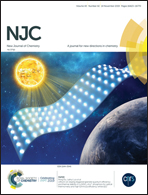A benzimidazole-based non-symmetrical tripodal receptor for the ratiometric fluorescence sensing of fluoride ions and solid state recognition of sulfate ions†
Abstract
Herein, a novel non-symmetric tripodal receptor has been synthesized and reported as a fluorescent chemosensor for fluoride ions with a remarkable red shift of 100 nm. The receptor was designed with benzimidazole and amide −NH functionalities to achieve fluorescence signals during anion sensing; the recognition behaviour of the probe towards fluoride ions was investigated using emission spectroscopy based on a ratiometric change with the limit of detection as low as 0.875 ppb as well as a visual change in colour from violet to cyan under UV light. 1H NMR studies confirmed the initial formation of the –NH⋯F− hydrogen bond and the subsequent deprotonation of benzimidazole and amide upon the addition of fluoride ions. In addition, an INHIBIT-type logic gate at the molecular level could be fabricated using the reversibility and the reusability of the probe towards the F− and H+ ions. Moreover, visual detection of fluoride ions in the solid state was feasible as the receptor-coated TLC plates and paper strips detected the former under UV light. In the protonated form, the asymmetric unit encompasses two molecules of the non-symmetrical receptor that bind two molecules of sulfate anions, and the benzimidazole −NHs have been found to be potent hydrogen bond donors.



 Please wait while we load your content...
Please wait while we load your content...